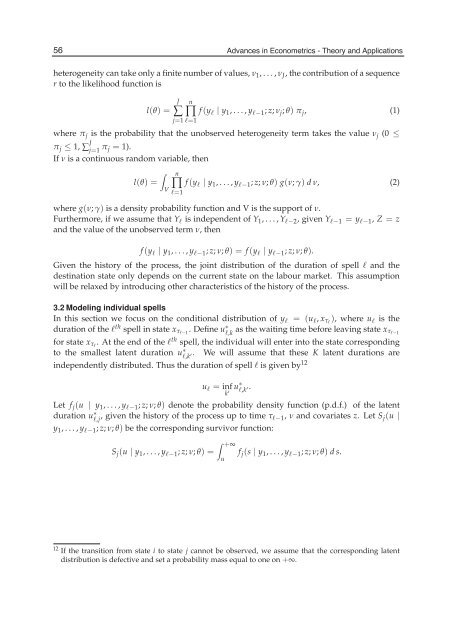The Limits of Mathematics and NP Estimation in ... - Chichilnisky
The Limits of Mathematics and NP Estimation in ... - Chichilnisky
The Limits of Mathematics and NP Estimation in ... - Chichilnisky
- No tags were found...
Create successful ePaper yourself
Turn your PDF publications into a flip-book with our unique Google optimized e-Paper software.
56 Advances <strong>in</strong> Econometrics - <strong>The</strong>ory <strong>and</strong> Applications10 Will-be-set-by-IN-TECHheterogeneity can take only a f<strong>in</strong>ite number <strong>of</strong> values, ν 1 ,...,ν J , the contribution <strong>of</strong> a sequencer to the likelihood function isl(θ) =J n∑ ∏ f (y l | y 1 ,...,y l−1 ; z; ν j ; θ) π j , (1)j=1 l=1where π j is the probability that the unobserved heterogeneity term takes the value ν j (0 ≤π j ≤ 1, ∑ J j=1 π j = 1).If ν is a cont<strong>in</strong>uous r<strong>and</strong>om variable, then∫l(θ) =n∏ f (y l | y 1 ,...,y l−1 ; z; ν; θ) g(ν; γ) d ν, (2)Vl=1where g(ν; γ) is a density probability function <strong>and</strong> V is the support <strong>of</strong> ν.Furthermore, if we assume that Y l is <strong>in</strong>dependent <strong>of</strong> Y 1 ,...,Y l−2 , given Y l−1 = y l−1 , Z = z<strong>and</strong> the value <strong>of</strong> the unobserved term ν, thenf (y l | y 1 ,...,y l−1 ; z; ν; θ) = f (y l | y l−1 ; z; ν; θ).Given the history <strong>of</strong> the process, the jo<strong>in</strong>t distribution <strong>of</strong> the duration <strong>of</strong> spell l <strong>and</strong> thedest<strong>in</strong>ation state only depends on the current state on the labour market. This assumptionwill be relaxed by <strong>in</strong>troduc<strong>in</strong>g other characteristics <strong>of</strong> the history <strong>of</strong> the process.3.2 Model<strong>in</strong>g <strong>in</strong>dividual spellsIn this section we focus on the conditional distribution <strong>of</strong> y l= (u l , x τl ), where u l is theduration <strong>of</strong> the l th spell <strong>in</strong> state x τl−1 . Def<strong>in</strong>e u ∗ l,k as the wait<strong>in</strong>g time before leav<strong>in</strong>g state x τ l−1for state x τl . At the end <strong>of</strong> the l th spell, the <strong>in</strong>dividual will enter <strong>in</strong>to the state correspond<strong>in</strong>gto the smallest latent duration u ∗ l,k ′ . We will assume that these K latent durations are<strong>in</strong>dependently distributed. Thus the duration <strong>of</strong> spell l is given by 12u l = <strong>in</strong>fk ′ u ∗ l,k ′.Let f j (u | y 1 ,...,y l−1 ; z; ν; θ) denote the probability density function (p.d.f.) <strong>of</strong> the latentduration u ∗ l,j , given the history <strong>of</strong> the process up to time τ l−1, ν <strong>and</strong> covariates z. Let S j (u |y 1 ,...,y l−1 ; z; ν; θ) be the correspond<strong>in</strong>g survivor function:S j (u | y 1 ,...,y l−1 ; z; ν; θ) =∫ +∞f j (s | y 1 ,...,y l−1 ; z; ν; θ) ds.u12 If the transition from state i to state j cannot be observed, we assume that the correspond<strong>in</strong>g latentdistribution is defective <strong>and</strong> set a probability mass equal to one on +∞.








